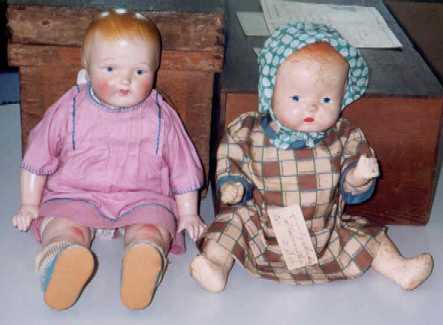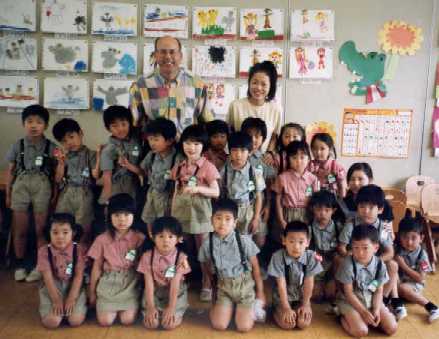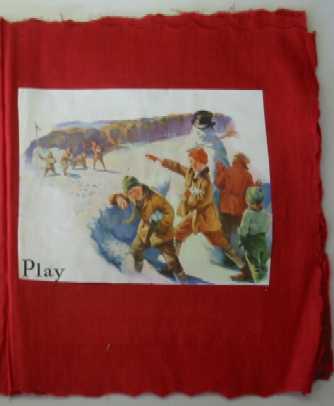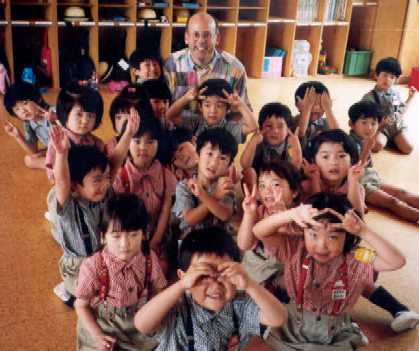|
|
|

|

|
Carolyn (right) and Other
Friendship Doll
|
|
|
This was the first visit for me and my wife Noriko to a Buddhist
kindergarten. Hitoshi Minagi, the director of Mikuma Kindergarten in Hita
City in Oita Prefecture, greeted us at the train station and walked with us
to the kindergarten. He and his father serve as priests at the Hita City
temple of the Shinshu Otani Buddhist sect, headquartered in Kyoto. The
kindergarten has over 100 students and was founded in 1926, one year before
the school received a Friendship Doll named Carolyn Becker from America.
|
|
|

|
|
|
With One Class
|

|
|
|
I found out about Mikuma Kindergarten when I read a
Nagasaki Shimbun
article about the school's two Friendship Dolls. Mrs. Yamashita, a reporter who I met last year, visited the kindergarten early this
year and provided Mr. Minagi with many materials and photos about the
Friendship Dolls and the homecoming visit of Miss Nagasaki, the Japanese
Friendship Doll from 1927. The two dolls from Mikuma Kindergarten participated
in an exhibition from February to April 2003 of Miss Nagasaki and the other
American Friendship Dolls remaining in Kyushu, Japan's southernmost main
island. Mikuma is one of very few schools in Japan to have two American
Friendship Dolls from 1927. The kindergarten has many records about the arrival
of the doll named Carolyn Becker in 1927, but Mr. Minagi does not have anything
related to the school's other Friendship Doll and does not know why the doll
was stored away for many decades along with Carolyn.
|
|
|
|
|

|

|
One page from four cloth albums
of photos and illustrations that came
with American Friendship Doll in 1927
|
|
|
Before the morning assembly for the kindergarten's
children, Mr. Minagi put on his Buddhist priest's black robe over his regular
clothes and a long strip of colored cloth around his neck. He took in his hand
a bracelet of colored beads, and he also gave us beads for use in prayers
during the assembly. The meeting began with the children reciting the words of
Buddha, and they then sang a religious song. Everyone at the assembly had
beads in their hands, so I tried to imitate the others in holding the beads.
Mr. Minagi went to the front, kneeled before an image of Buddha, and said a
prayer. Next one of the teachers talked to the students about not bringing
certain items (e.g., candy, cards) to the school since not all the children
could get the item so there could be bad feelings. Mr. Minagi then pointed to
the two American dolls sitting on a table in front and told the history of
these dolls. Next he introduced Noriko and me to the children. I gave them a
fun lesson about the rules to follow when shaking hands, and I presented each
of the teachers with a Japanese-American friendship pin with the two countries'
flags.
|
|
|

|
|
|
Hand Signals from Children
|

|
|
|
After the assembly, Noriko and I gave separate
presentations to the two classes of four-year-olds and two classes of
five-year-olds. At the start of my presentations, the children sat away from
me, but they soon came closer and closer as I showed them items used by
American children during holidays.
Mr. Minagi laid out on the meeting room table many articles related to the
Friendship Dolls. He showed us the passport and
steamship ticket of Carolyn
Becker and four handmade cloth albums that came with the doll in 1927. The
albums are about 20 pages each with clippings of photos and drawings from
American magazines. The school also has a 1927 graduation photo with Carolyn
sitting in the midst of the children and a 1927 photo of the welcoming ceremony
for the doll. A couple of newspaper reporters also visited in the morning to
view the Friendship Doll materials and to write about our visit.
Mr. Minagi gave us several nice gifts, including a Buddhist calendar with
sayings translated to English, a couple of Buddhist education books for Noriko,
and plastic bead bracelets used in praying. He helped us carry our luggage to
the station, and we also received bento box lunches to eat on the train
to our next school visit in Yamaguchi City.
|
|
|